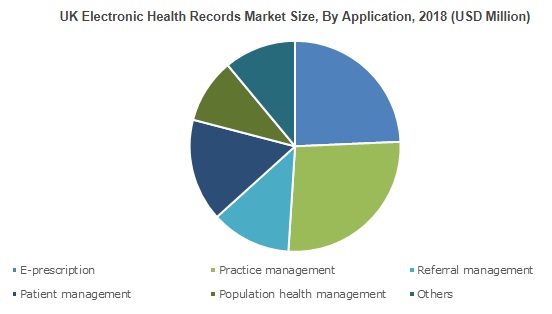UK Electronic Health Records Market will achieve 4.5% CAGR up to 2025

The Electronic health records market has garnered a commendable remuneration portfolio over the recent years with the healthcare industry rapidly marching toward an analytical, data-driven approach. Add to it, the rising prevalence of the technology across myriad healthcare institutes to facilitate affordable, efficient, and streamlined healthcare services has further propelled the electronic health records market trends. In a recent turn of events, New York’s NYU Langone Health network of hospitals and medical offices has made it to the headlines for leveraging electronic medical records systems to identify the unvaccinated patient base in the U.S. and prevent what can be claimed as the worst measles outbreak in the country in 25 years. The hospital, as per the reports, has enabled alerts in its EHR systems that will notify the doctors about the patient whereabouts in an outbreak area, based on their zip code.
Speaking further on the move, the alerts apparently were developed deployed using software from Epic Medical Systems, which is one of the prominent companies in the electronic health records industry landscape. The healthcare software giant has also issued guide to educate health systems about the usage of electronic health records to identify and reach the unvaccinated patient base.
The move strongly stands as a validation to the strong deployment of EHR systems to improve the healthcare infrastructure, in terms of cost as well as efficiency and safety. Another pivotal instance standing as a testimony to the above statement is Grifol’s pharmacykeeper bidirectional integration with EPIC. The move was announced in a bid to enhance efficiency, patient safety, and compliance with state compounding regulations.
To access a sample copy of "Electronic Health Records Market" report in detail along with the table of contents @ https://www.gminsights.com/request-sample/detail/3130
It is imperative to mention that the broadening cloud infrastructure has a crucial role to play in the proliferating electronic health records industry outlook. The technological appetite of the medical ecosphere has indeed redefined the data storage capabilities with EHR standing as a classic example of this transformation. In fact, cloud based electronic health record systems procured a significant chunk of the EHR systems product landscape in 2018, with a recorded valuation of USD 12.5 billion. Affordability, speed, flexibility, and wider accessibility are some of the parameters driving the demand for cloud/web based electronic health records market worldwide.
Not to mention, the cloud based EHR sector has been an area of heavy investments by the software healthcare industry giants in the recent years. An instance validating the statement – Rhinogram, a renowned telehealth industry player recently announced the integration of its telehealth solution with Sleep Health MD’s EHR. The move was deemed to significantly aid Sleep Health communicate with patients in real time facilitating the overall engagement. The deal, as cited by experts, was another move by Rhinogram aimed at bridging the gap between providers and patients, enabling efficient and streamlined patient management. In terms of revenue potential, patient management stands as a potential application in EHR market with a projected CAGR of 6% over 2019-2025.
Considering the advanced healthcare model and its directly proportional relationship with the EHR market trends, the stance of established economies with regards to claiming the regional share is substantially strong. On that note, U.S. will emerge as a strong regional contender with a target CAGR of 5% over 2019-2025. Other than the favorable medical infrastructure, the government backing and massive investments in the region will further proliferate the market penetration. In 2009, the United States government had passed a legislation known as the Health Information Technology for Economic and Clinical Health Act (HITECH). This legislation has apportioned billions of dollars to incentivize eligible healthcare professionals throughout the country to practice EHR systems.
A data by American Health Association suggests that more than 9 in 10 hospitals in the U.S. have exercised their EHR data to inform clinical practice in 2017. Also, 8 out of 10 hospitals have used their EHR information to measure organization performance, aid quality improvement or monitor patients’ safety, 7 out of 10 hospitals utilized EHR to inform strategic planning, identify high risk patients, create individual provider profiles or measure unit performance, 6 in 10 to assess adherence to guidelines or identify care gaps for patients; and 5 out of 10 to advance an approach to query for data – Stats claiming the strong positioning of the U.S. in global electronic health records market landscape.
While the established countries exhibit an upper hand in the digitized healthcare model, an anticipated trend remains the revenue battle with the emerging countries. Asia Pacific economies, specifically India, is estimated to generate a heavy momentum in the overall landscape, with massive government push to facilitate ‘Digital healthcare in India’ – e-Healthcare. Amidst these trends, the innovation and strategic landscape of electronic health records market will witness a dynamism of sorts in the coming years. In terms of commercialization, the worldwide EHR market share is forecast to surpass USD 38 billion by 2025.










